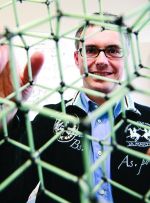News
EPJ E – Graphical abstracts now required in EPJ E
- Details
- Published on 10 August 2012
We are pleased to inform the readers and authors of EPJ E that from now on articles published in EPJ E will feature a graphical abstract. While it is not meant to provide specific results, this element will serve the purpose of conveying visually the gist of the article, along with the title. Authors may use an item already present in the manuscript or a purpose-made graphic. The use of color is strongly encouraged. Images previously published under the copyright of other publishers cannot be considered.
EPJ Plus – Determination of a time shift in the OPERA setup using high-energy horizontal muons in the LVD and OPERA detectors
- Details
- Published on 10 August 2012

The halls of the INFN Gran Sasso Laboratory (LNGS) were built in the 1980s based on the design of A. Zichichi and oriented towards CERN for experiments on neutrino beams. In 2006, the CERN Neutrinos to Gran Sasso (CNGS) beam was ready and the search could start for tau-neutrino appearances in the muon-neutrino beam produced at CERN. The OPERA detector was designed and built for this purpose.
EPJ E - Giraffes are living proof that cells’ pressure matters
- Details
- Published on 10 August 2012

A model that describes dividing cells within human tissues from the perspective of physicists could help further the understanding of cancer growth.
Physicists from the Curie Institute, France, explored the relative impact of the mechanical pressure induced by dividing cells in biological tissues. This approach complements traditional studies on genetic and biochemical signalling mechanisms to explain experimental observations of how biological tissues evolve. This work, recently published in EPJE, could have significant implications for the understanding of cancer growth.
EPJ Plus – The “inertia of heat” concept revisited
- Details
- Published on 10 August 2012
What is the general relativistic version of the Navier-Stokes-Fourier dissipative hydrodynamics? Surprisingly, no satisfactory answer to this question is known today. Eckart's early solution [Eckart, Phys. Rev. 58, 919 (1940)], is considered outdated on many grounds: the instability of its equilibrium states, ill-posed initial-value formulation, inconsistency with linear irreversible thermodynamics, etc. Although alternative theories have been proposed recently, none appears to have won the consensus.
EPJ B has a new Editor in Chief to handle theory and simulations in condensed matter
- Details
- Published on 10 August 2012

From July 2012 Angel Rubio succeeds Luciano Colombo as Editor in Chief of EPJ B for the part of condensed matter theory and modeling. Professor Rubio is the head of the NanoBio spectroscopy group at the Universidad del País Vasco in Spain and leader of the theoretical spectroscopy group at the Fritz Haber Institut in Berlin. His group collaborates with many other experimental and theoretical research groups, as well as groups from industry. He has contributed with a large number of publications to the development of novel theoretical tools to investigate the electronic response of solids, nanostructures, biomolecules and hybrid materials to external electromagnetic fields. He has numerous honors and awards to his name which he garnered throughout his academic career.
EPJ A - Existence of neutron-rich superheavy element 116 confirmed
- Details
- Published on 10 August 2012

The synthesis of a superheavy element with the proton number Z=116 has been studied at the velocity filter SHIP of GSI in Darmstadt using a 48Ca beam on radioactive 248Cm targets. At excitation energies of the compound nuclei of 40.9 MeV, four decay chains were measured, which were assigned to the isotope 292116 produced in 4n channel, and one chain, which was assigned to 293116 produced in 3n channel. All chains are terminated by spontaneous fission decays of either 277Hs or 284Cn isotopes on the shoreline of the neutron-rich superheavy island.
EPJ Data Science - Countering crowd control collapse
- Details
- Published on 10 August 2012

Understanding crowd dynamics can prevent disaster at cultural or sports events.
Physicists investigating a recent crowd disaster in Germany found that one of the key causes was that at some point the crowd dynamics turned turbulent, akin to behaviour found in unstable fluid flows. The study, led by Dirk Helbing from the Risk Center at the Swiss Federal Institute of Technology ETH Zurich, Switzerland, is published in EPJ Data Science.
EPJ B - Cell dynamics simulations: a fast way to profile block copolymers
- Details
- Published on 10 August 2012
Cell Dynamics Simulation (CDS) is a fast and efficient method for the simulation of kinetic processes in large-scale phase separation systems.
We review the application of this method to block copolymer systems and illustrate its use by examining a set of physical phenomena occurring in these systems. In spite of the simplicity of the model, such applications of CDS demonstrate that it is capable of accurately describing complex phenomena and is, therefore, a complementary method which can serve as a precursor to slower, more elaborate techniques.
Large Scale Simulation of block copolymers with cell dynamics M. Pinna and A.V. Zvelindovsky, Eur. Phys. J. B (2012) 85: 210, DOI: 10.1140/epjb/e2012-20968-6
EPJ C - Neutrons escaping to a parallel world?
- Details
- Published on 10 August 2012

An anomaly in the behaviour of ordinary particles may point to the existence of mirror particles that could be candidates for dark matter responsible for the missing mass of the universe. In a paper recently published in EPJC, researchers hypothesised the existence of mirror particles to explain the anomalous loss of neutrons observed experimentally. The existence of such mirror matter had been suggested in various scientific contexts some time ago, including the search for suitable dark matter candidates.
EPJ E - Modelling the demise of migrating brain tumour cells
- Details
- Published on 10 August 2012

Evolution of brain tumour cells under treatment reveal that it is the peripheral tumour cells that need to be targeted
An Israeli physicist has developed a theoretical model to simulate the evolution of highly proliferating brain tumour core cells subjected to treatment by alternating radio frequency electric field. The research, by Alexander Iomin from the Israel Institute of Technology Technion in Haifa, has just been published in EPJE. In another model, the author examines the possibility of enhancing the level of treatment by targeting the outer area of the tumour.





